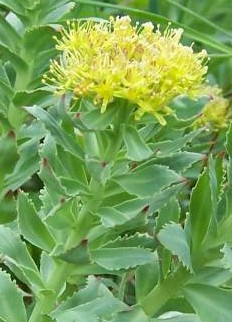 Rose root, also known as golden root, is a herbaceous perennial native to cold regions including the Arctic, Scandinavia and the mountains of central Asia, central Europe, and eastern North America where it grows in such places as cliffs and crevices, as well as along stream banks and coastal beaches. The bluish-gray leaves are toothed and slightly fleshy. Clusters of small male and female flowers are usually produced on separate plants but occasionally on the same plant. Bloom time is from early to late summer and may occur before the leaves fully open. Flowers are greenish, yellow, reddish or purple, and male flowers have long attractive stamens. The root stock is fleshy and has a rose scent, giving rise to the common name rose root. Plants have been raised for hundreds of years as a cure for a variety of ailments including cancer, anxiety, migraines, and the common cold.
Rose root, also known as golden root, is a herbaceous perennial native to cold regions including the Arctic, Scandinavia and the mountains of central Asia, central Europe, and eastern North America where it grows in such places as cliffs and crevices, as well as along stream banks and coastal beaches. The bluish-gray leaves are toothed and slightly fleshy. Clusters of small male and female flowers are usually produced on separate plants but occasionally on the same plant. Bloom time is from early to late summer and may occur before the leaves fully open. Flowers are greenish, yellow, reddish or purple, and male flowers have long attractive stamens. The root stock is fleshy and has a rose scent, giving rise to the common name rose root. Plants have been raised for hundreds of years as a cure for a variety of ailments including cancer, anxiety, migraines, and the common cold.
Type: Herbaceous perennial
Bloom: Terminal clusters of small male and female flowers usually develop on separate plants but some bisexual plants occur. Flowering is from early to mid summer summer and petals are greenish, yellow, reddish or purple.
Size: 2-14″ H x 12″ W
Light: Full sun
Soil: Fertile, moist to medium dry, well-drained; drought tolerant when established
Care: Low maintenance
Hardiness: Zones 2-7
Pests and Diseases: None of significance
Propagation: Seed; division in late summer into fall; cuttings of basal shoots in early summer
Companion Plants: Campanula poscharskyana, Geranium ‘Ballerina’.
